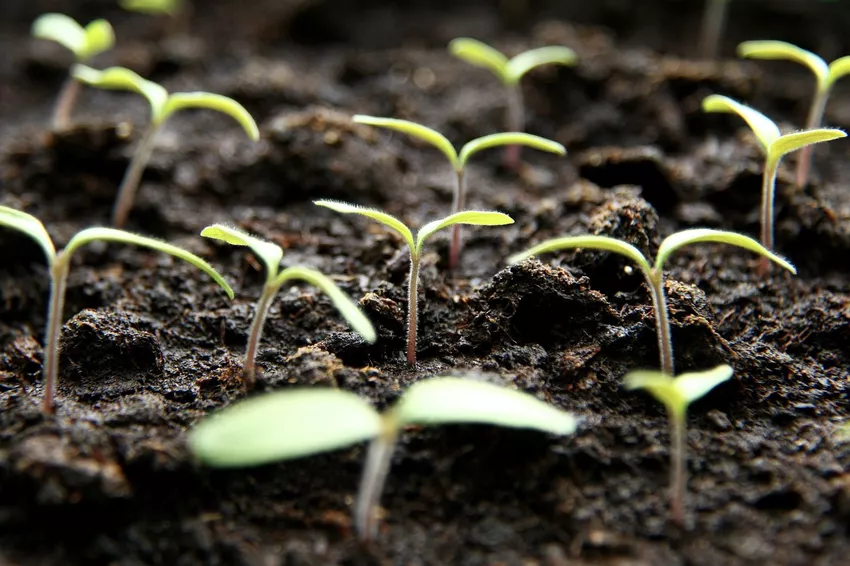Tomato cultivation begins early in the year. We show what needs to be considered and which substrate is best suited for growing tomato plants.

Tomatoes (Solanum lycopersicum) are the absolute favorites of many hobby gardeners. In summer, tomato plants adorn the vegetable beds and house walls in many gardens with their grass-green foliage and colorful fruits. But in order to be able to successfully grow tomatoes in your own garden, the sowing must first succeed. Preferring your own tomatoes is not only worthwhile for garden owners, but also for balcony gardeners. With a little space on the window sill, you too will soon have small seedlings growing towards the sun. In this article you will find instructions and helpful tips on how to sow tomato seeds.
Sowing tomatoes: when is the right time?
The right time to sow tomato seeds is between the end of February and the end of March. Proper young plants can then be planted in the greenhouse or bed in May. Tomatoes are among the vegetables with a long cultivation period. Pulling them forward gives the plants a head start indoors while it's still far too cold outside for the warmth-loving sun-worshippers. Tomatoes sown too early tend to wilt quickly, which means they develop very long shoots and often fall over because the sun is not yet strong enough to supply them with sufficient energy. Tomatoes sown too late produce fruit late, which may not ripen until autumn.

Sowing tomatoes: temperature and location
To prefer tomatoes, it is best to choose a warm and bright window sill. For the small tomato seedlings, light and heat are particularly important. The germination temperature for tomatoes should be around 20 - 22 °C. In this way, the first seeds often germinate after just a few days. However, there are also solutions for dark and cool corners: LED lighting especially for plants can reproduce the color spectrum that is important for the tomato fairly well and prevents the typical yellowingdue to lack of light. A heating mat keeps the roots of the tomato plants warm even on cooler nights and encourages the seeds to germinate faster.

Step-by-step instructions for sowing tomatoes
For sowing tomato seeds, you should first decide on a suitable container. Here you can either use multi-plates made of plastic or alternative seed containers. An old egg carton or biodegradable pots made of coconut substrate are suitable for this, for example, but other vessels can also be visually convincing. Since tomato plants are pricked out just a few weeks after sowing anyway, small growing containers with little soil volume are also ideal. A suitable seed soil for tomatoes must be permeable, water-storing and low in nutrients in order not to damage the tender roots. A low-s alt and nutrient-poor potting soil, such as our Plantura organic herb and seed soil, is ideal for this. Compact the substrate slightly with your fingers and refill with soil. Press the surface down a little and place the tomato seeds on top. The seeds are now covered with about 0.5 cm of soil. It is advisable to use stick-in labels or something similar so that you will know later which type of tomato you have sown. Inscriptions with pencil or waterproof felt markers survive repotting and watering.
Now it has to be watered a little to stimulate germination. It is important that the soil is always slightly damp from this moment, but never wet. The freshly germinated, tender roots do not tolerate drying out very well at this stage. However, if the soil is wet for days, the seeds and roots can rot. It is therefore important to avoid both dryness and extreme wetness. A clear film cover or plastic hood will help maintain high humidity and reduce evaporation from the soil. This means that less frequent watering is required and it is easier for the seedlings to germinate and free themselves from the seed coat. A small seed greenhouse or a home-made mini greenhouse are also suitable for this. After just 3 - 10 days, depending on the variety and age of the seeds, the first little plants and cotyledons appear.

Sowing tomatoes: Instructions at a glance
- Seeding vessel (multi-plate, potty or alternative vessel such as aFill egg carton) with nutrient-poor seed soil, compress slightly and refill again.
- Spread the seeds on the surface, cover with approx. 0.5 cm of soil and press down.
- Water the soil and seeds lightly and keep moist in the future.
- Place in a warm, bright location (preferably a window sill), alternatively illuminate with special plant LEDs.
- Transparent cover, mini greenhouse and heating mat accelerate germination.
Tip: Sowing tomatoes is even easier with our Plantura vegetable growing set. It includes everything you need to grow vegetables successfully - seeds, nursery pots, substrate, plant labels and a reusable mini greenhouse. In addition to tomatoes, you can also sow radishes, chard, carrots and beets with the vegetable set.
After a few days to weeks, the tomato seedling will grow and should be transplanted into nutrient-rich soil. We give tips on how to transplant and plant tomatoes.